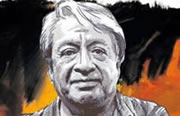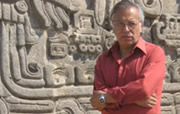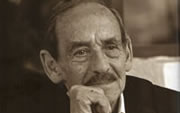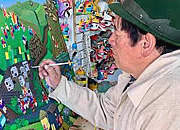The collection
This was built up over travels in the 1990s around Latin America but particularly whilst living in Quito, Ecuador for a year. We were simply stunned by the range of beautiful works expressing the colours, traditions, dreams and myths of the people.

Oswaldo Guayasamín
Perhaps the most famous Ecuadorian painter, Guayasamín was born in 1919 as the oldest of 10 children and took to art early in his life. According to his Wikipedia profile, he was named the best South American painter in 1957, at the Fourth Biennial of São Paulo. Most of his art is concerned with oppression in the lower social classes. more details

Washington Iza
Born in Quito in 1947, Iza became well-known as a highly innovative artist. In 1969, along with 3 other artists known as the 4 Musketeers, he established an "Anti Salon" in Guayaquil. He has given many exhibitions and won a number of prizes in other countries, including France.

Napoleón Paredes
Born in Quito in 1947, Paredes inhabits the world between dream and nightmare with works that draw on Bosch and Brueghel, with the occasional touch of Botero. more details (Spanish)

Eduardo Kingman
Born in Loja, Ecuador, in 1913. Along with Guayasamín, one of Ecuador's most famous artists and in similar way his work expresses the life and hardships of the indigenous community. His signature theme is his depiction of hands. His original prints and paintings were exhibited internationally in such cities as Paris, Washington, San Francisco, and elsewhere in Latin America. more details

Roberto Fabelo
Roberto Fabelo is the most successful Cuban contemporary painter, sculptor, and illustrator living in Cuba. Born in 1951, he has won many prizes inside and outside Cuba, and is highly considered in USA and elsewhere. more details

Tigua
Tigua art has become famous over the years for its primitive art. Tigua is a small village community high in the Andes about 90kms from Quito in Ecuador, and not far from the shores of Lake Quilatoa. It had always been locally well-known for their hand-painted drumskins. In the 1970s Olga Fisch, a Hungarian Jew and Bauhaus artist who came to Ecuador in 1939, suggested that the community apply the same approach to pictures that could be exhibited on a wall. So was born the tradition of rural scenes, traditions and myths painted typically on sheepskin stretched over a decorated wooden frame.
There are now estimated to be over 300 painters in the community. Judging by Tigua works appearing in a Google search, commercial tourism has resulted in a significant increase of supply at the expense of quality. When we were buying, in 1989 and early 1990s, only a few galleries carried Tigua art, and quality was noticeably higher. more details